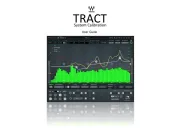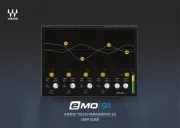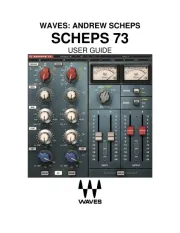MIA Laboratories 413 Tape Saturator Handleiding
MIA Laboratories
Audiosoftware
413 Tape Saturator
Bekijk gratis de handleiding van MIA Laboratories 413 Tape Saturator (5 pagina’s), behorend tot de categorie Audiosoftware. Deze gids werd als nuttig beoordeeld door 41 mensen en kreeg gemiddeld 4.5 sterren uit 21 reviews. Heb je een vraag over MIA Laboratories 413 Tape Saturator of wil je andere gebruikers van dit product iets vragen? Stel een vraag
Pagina 1/5

413 TAPE SATURATOR
User Guide
MIA LABORATORIES

Greetings and Welcome!
Thank you for choosing MIA Laboratories.
Please take the time to read through this user guide in order to get familiar with the components and use of 413 Tape Saturator.
Overview
The 413 Tape Saturator reproduces the non-linear characteristics that would result when overdriving analog tape, as magnetic
saturation occurs with increasing amplitude of the ‘recorded’ signal. It offers 3 different types of Analog Tape, as well as 3 different
types of distortion.
For the saturation process, the signal gets dynamically changed, especially high frequency information, in response to its amplitude.
The resulting effect simulates the saturation of analog tape, in a controllable environment which can be adjusted according to your
preference.
The user can choose among 3 different types of Analog Tape, each corresponding to the noise and saturation characteristics of 3
different well known tape brands.
3 distortion types are also available, enabling the user to produce the harmonic content/distortion one would get by overdriving
certain Tube or Transistor circuits.
Features
● Advanced Tape Saturation algorithm
● Tube, Transistor and Soft Clipping Distortion
● Real tape-hiss
● ‘IEC on NAB’ playback equalization mode

Control functions and specifications
INPUT: Controls the level of input signal to the 413 Tape Saturator. Ranges from -48 to +6 dB.
OUTPUT: Controls the amount of output attenuation. Ranges from 0 to -48 dB.
DISTORTION: Selects the type of distortion produced. Type A and Type B simulate Tube and Transistor circuits, while Type C is
based on a soft clipping algorithm.
AMOUNT: Sets the amount of distortion that will be applied to the signal for distortion types A and B, while it acts like a dry/wet
control for Type C. Ranges from 0 to 11.
SATURATION: Sets the amount of Tape Saturation applied, ranging from 0 to 100%.
The effect and ‘depth’ of this adjustment is also affected by Tape Type, Flux Ref. and the nominal level of the signal itself.
So, the more the VU meters are driven into the red, the more saturation takes place.
TAPE: There are three different types to choose from. Each type carries its own Hiss noise and affects the saturation Depth.
HISS: Sets the amount of Hiss that will be introduced to the signal. It’s sound changes according to Tape Type.
Also note that the hiss noise is continuous and does not ‘start’ and ‘stop’ according to the DAW transport.
It will therefore be also present when signals are being monitored instead of being played-back by chanell tracks, and can be
completely turned-off by setting to 0.
EQUALIZATION:
NAB
: No change to the signal since the 413’s default state is NAB.
IEC
: Applies an approximation of the frequency response that would result if the original material was recorded in NAB and played
back with IEC eq.
FLUX REF.: Adjusts the “Flux reference” of the tape, therefore affecting the Depth of Tape Saturation, and the meters’ calibration.
Product specificaties
| Merk: | MIA Laboratories |
| Categorie: | Audiosoftware |
| Model: | 413 Tape Saturator |
Heb je hulp nodig?
Als je hulp nodig hebt met MIA Laboratories 413 Tape Saturator stel dan hieronder een vraag en andere gebruikers zullen je antwoorden
Handleiding Audiosoftware MIA Laboratories

10 December 2024

10 December 2024

4 Maart 2024

4 Maart 2024

4 Maart 2024

4 Maart 2024

4 Maart 2024

4 Maart 2024

4 Maart 2024

4 Maart 2024
Handleiding Audiosoftware
- Best Service
- Ujam
- Air
- Corel
- Bome
- Blue Cat Audio
- Tek'it Audio
- Native Instruments
- Steinberg
- Kuassa
- TAL Software
- Chocolate Audio
- Xils Lab
- Atomix
- Antares
Nieuwste handleidingen voor Audiosoftware

10 April 2025

8 April 2025

2 April 2025

2 April 2025

2 April 2025

2 April 2025

2 April 2025

2 April 2025

2 April 2025

2 April 2025